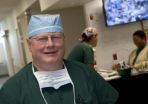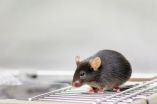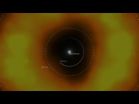(Press-News.org) Tampa, FL (March 6, 2014) – A method called molecular subtyping can help doctors better determine which of their breast cancer patients are at high risk of getting breast cancer again, a new study led by the University of South Florida reports. This sophisticated genetic profiling of an individual's specific tumor offers an additional resource to help identify patients who would most benefit from chemotherapy and those who would not.
The findings by researchers from USF and other institutions were presented in a scientific poster at the Miami Breast Cancer Conference, held March 6-9 in Miami Beach, Fla.
"The most important takeaway for our colleagues in breast cancer diagnosis and treatment is the potential value of molecular subtyping to personalize and improve each woman's treatment," said principal investigator Charles E. Cox, MD, McCann Foundation Endowed Professor of Breast Surgery, USF Health Morsani College of Medicine.
Molecular subtyping is a way of classifying breast cancer tumors into one of four genetically-distinct categories, or subtypes: Luminal A, Luminal B, Basal (a subset of triple negative), and HER2-type. Each subtype responds differently to different kinds of treatments, and some subtypes indicate a higher risk of disease recurrence.
"Our data showed that a substantial number of breast cancer patients -- classified as low risk by one particular genomic test -- turn out to be at high risk of recurrence once we determined their subtype," Dr. Cox said. "These are mostly Luminal B patients, and their physicians might not fully understand their patient's situation unless they do subtyping."
The USF study examined why different genomic tests for breast cancer sometimes provide contradictory information about risk of recurrence. The key findings involved the 70-gene MammaPrint® test; the 21-gene Oncotype DX® test, which is an earlier commercially available test; and Mammostrat®, a gene profiling test performed on slides of the breast tumor by a pathologist. The tests have generally been assumed to provide equivalent information about recurrence risk, but that is proving not to be the case.
VIDEO:
Dr. Charles Cox of the University of South Florida, Tampa FL, discusses the key findings of molecular subtyping for breast cancer study presented Mar. 6, 2014, at the annual Miami...
Click here for more information.
Researchers examined tumor samples from a total of 148 patients. The greatest discordance (lack of agreement) about risk of disease recurrence occurred in a group of 51 patients. Of those 51, all were stratified by MammaPrint as high risk of recurrence, while Oncotype classified 18 of them (35 percent) as low risk.
BluePrint®, an 80-gene test to identify a tumor's molecular subtype, was also used for those stratified by MammaPrint. This process revealed that the 51 patients were Luminal B, a molecular subtype with a high risk of recurrence.
Patients with a high risk of recurrence are normally counseled to receive chemotherapy following surgery to prevent the cancer from returning. In contrast, women whose subtype has a low risk of recurrence (Luminal A) will not benefit from the addition of chemotherapy. They may thus be able to safely avoid chemotherapy and its potentially damaging side effects. At the same time, they can be prescribed treatments such as hormonal therapy known to benefit those with their subtype.
The additional information provided by genomic tests and molecular subtyping may help reduce overall treatment costs for breast cancer, by targeting chemotherapy only for those women who will benefit from it, Dr. Cox said "Personalized treatment guided by these tests may also extend the time that patients are free of their cancer."
Registered nurse George Ann Vincent, a Tampa, Fla. resident and a patient of Dr. Cox, was diagnosed with early-stage breast cancer last year. The 70-gene test determined that her tumor had a high risk of recurrence, so she was prescribed chemotherapy.
"I'm certainly grateful that I'm getting the treatments that are right for me," Vincent said. "Chemotherapy is no picnic, but it can save lives. The genomic tests I took made me confident I was being sent in absolutely the right direction."
Dr. Cox clarified that discordance does not necessarily show that some genomic test results were wrong.
"These tests use different genes and were validated on different types of populations," he said. "But if physicians use molecular subtyping as we did in this study, they will have valuable, additional information to guide the appropriate treatment for each patient."
Using molecular subtyping in combination with traditional biomarkers, like tumor grade and hormone receptor status, for determining the biological nature of a woman's cancer is a recommended guideline for breast cancer treatment in both the United States and Europe, Dr. Cox said.
INFORMATION:
Other poster co-authors included researchers from Florida Hospital Tampa; Morton Plant Hospital, Clearwater, Fla.; and Agendia NV, a molecular diagnostics firm.
USF Health's mission is to envision and implement the future of health. It is the partnership of the USF Health Morsani College of Medicine, the College of Nursing, the College of Public Health, the College of Pharmacy, the School of Biomedical Sciences and the School of Physical Therapy and Rehabilitation Sciences; and the USF Physician's Group. The University of South Florida is a global research university ranked 50th in the nation by the National Science Foundation for both federal and total research expenditures among all U.S. universities.
Molecular subtyping of breast cancer can better identify women at high risk of recurrence
University of South Florida-led study helps refine personalized approach to breast cancer diagnosis and treatment
2014-03-07
ELSE PRESS RELEASES FROM THIS DATE:
How seeing the same GP helps your health
2014-03-07
Patients are more likely to raise a health problem with a doctor they've seen over time and have built-up a relationship with, new research has revealed. The insight comes as an increasing number of patients struggle to see the same GP.
Researchers from the University of Bristol will share their findings with health practitioners and researchers at the South West Society for Academic Primary Care (SW SAPC) meeting today [07 March].
Seeing the same GP is thought to be important in ensuring quality of patient care, as the doctor will have better knowledge of the patient's ...
Primary care needs to 'wake-up' to links between domestic abuse and safeguarding children
2014-03-07
Researchers looking at how healthcare professionals deal with domestic violence cases have identified that GPs, practice nurses and practice managers are uncertain about how to respond to the exposure of children to domestic violence.
With at least 1.2 million women and 784,000 men experiencing domestic violence and abuse in England and Wales each year, the negative effect on families and children can be far-reaching. Childhood exposure to domestic violence and abuse can result in long-term behavioural, mental health and education problems.
However, new research has ...
Researchers map European climate change
2014-03-07
The majority of Europe will experience higher warming than the global average if surface temperatures rise to 2 °C above pre-industrial levels, according to a new study published today.
Under such a scenario, temperatures greater than the 2 °C global average will be experienced in Northern and Eastern Europe in winter and Southern Europe in summer; however, North-Western Europe—specifically the UK—will experience a lower relative warming.
The study, which has been published today, 7 March, in IOP Publishing's journal Environmental Research Letters, also shows that in ...
Drug protects mice against malaria brain damage, raises levels of BDNF in humans
2014-03-07
Cerebral malaria is a serious complication of infection with the malaria parasite, affecting approximately one in a thousand children in areas where malaria is common. Many of the patients die, and among those who survive, about a third have lasting cognitive and neurological disabilities, including epilepsy and learning disorders. A study published on March 6th in PLOS Pathogens shows that a known drug can prevent brain damage in a cerebral malaria mouse model and eliminate subsequent neurological deficits.
Infection with the malaria parasite elicits a strong immune ...
Simple urine test detects common causes of kidney dysfunction after transplantation
2014-03-07
Washington, DC (March 6, 2014) — A new noninvasive urine test can distinguish among different causes of acute kidney dysfunction after transplantation. The test, which is described in a study appearing in an upcoming issue of the Journal of the American Society of Nephrology (JASN), may allow patients to avoid invasive kidney biopsies when their transplanted organ is not functioning properly.
When creatinine levels are elevated in the blood of a kidney transplant recipient, it is an indication that the transplanted kidney is not functioning well. There are several reasons ...
Birds display lateralization bias when selecting flight paths
2014-03-07
Flocks of birds manage to navigate through difficult environments by individuals having predispositions to favour the left- or right-hand side, according to research published in PLOS Computational Biology this week.
Scientists at The University of Queensland's Queensland Brain Institute (QBI) and the Australian Research Council Centre of Excellence in Vision Science found that budgerigars display individual bias to fly to the left or right. This allows flocks to quickly navigate past obstacles by being able to split and not slow down due to crowding.
Dr Partha Bhagavatula, ...
Fighting for survival in the gut: Unravelling the hidden variation of bacteria
2014-03-07
This news release is available in Portuguese.
Our intestines harbour an astronomical number of bacteria, around 100 times the number of cells in our body, known as the gut microbiota. These bacteria belong to thousands of species that co-exist, interact with each other and are key to our health. While it is clear that species imbalances may result in disease, it is unclear at what pace does each species in the gut evolves, a process that contributes to the chance of a particular innocuous species becoming harmful to the host.
In the latest issue of the scientific ...
Contacts better than permanent lenses for babies after cataract surgery
2014-03-06
For adults and children who undergo cataract surgery, implantation of an artificial lens is the standard of care. But a clinical trial suggests that for most infants, surgery followed by the use of contact lenses for several years—and an eventual lens implant—may be the better solution. The trial was funded in part by the National Eye Institute (NEI), a component of the National Institutes of Health.
A cataract is a clouding of the eye's lens, and can be removed through a safe, quick surgical procedure. After cataract removal, most adults and children receive a permanent ...
NASA's Hubble Telescope witnesses asteroid's mysterious disintegration
2014-03-06
NASA's Hubble Space Telescope has recorded the never-before-seen break-up of an asteroid into as many as 10 smaller pieces.
Fragile comets, comprised of ice and dust, have been seen falling apart as they near the sun, but nothing like this has ever before been observed in the asteroid belt.
"This is a rock, and seeing it fall apart before our eyes is pretty amazing," said David Jewitt of the University of California at Los Angeles, who led the astronomical forensics investigation.
The crumbling asteroid, designated P/2013 R3, was first noticed as an unusual, fuzzy-looking ...
Nearby star's icy debris suggests 'shepherd' planet
2014-03-06
VIDEO:
NASA Goddard's Aki Roberge explains how observations with the Atacama Large Millimeter/submillimeter Array in Chile tell us about poison gas, comet swarms and a hypothetical planet around Beta Pictoris....
Click here for more information.
An international team of astronomers exploring the disk of gas and dust around a nearby star have uncovered a compact cloud of poisonous gas formed by ongoing rapid-fire collisions among a swarm of icy, comet-like bodies. The researchers ...
LAST 30 PRESS RELEASES:
Why nail-biting, procrastination and other self-sabotaging behaviors are rooted in survival instincts
Regional variations in mechanical properties of porcine leptomeninges
Artificial empathy in therapy and healthcare: advancements in interpersonal interaction technologies
Why some brains switch gears more efficiently than others
UVA’s Jundong Li wins ICDM’S 2025 Tao Li Award for data mining, machine learning
UVA’s low-power, high-performance computer power player Mircea Stan earns National Academy of Inventors fellowship
Not playing by the rules: USU researcher explores filamentous algae dynamics in rivers
Do our body clocks influence our risk of dementia?
Anthropologists offer new evidence of bipedalism in long-debated fossil discovery
Safer receipt paper from wood
Dosage-sensitive genes suggest no whole-genome duplications in ancestral angiosperm
First ancient human herpesvirus genomes document their deep history with humans
Why Some Bacteria Survive Antibiotics and How to Stop Them - New study reveals that bacteria can survive antibiotic treatment through two fundamentally different “shutdown modes”
UCLA study links scar healing to dangerous placenta condition
CHANGE-seq-BE finds off-target changes in the genome from base editors
The Journal of Nuclear Medicine Ahead-of-Print Tip Sheet: January 2, 2026
Delayed or absent first dose of measles, mumps, and rubella vaccination
Trends in US preterm birth rates by household income and race and ethnicity
Study identifies potential biomarker linked to progression and brain inflammation in multiple sclerosis
Many mothers in Norway do not show up for postnatal check-ups
Researchers want to find out why quick clay is so unstable
Superradiant spins show teamwork at the quantum scale
Cleveland Clinic Research links tumor bacteria to immunotherapy resistance in head and neck cancer
First Editorial of 2026: Resisting AI slop
Joint ground- and space-based observations reveal Saturn-mass rogue planet
Inheritable genetic variant offers protection against blood cancer risk and progression
Pigs settled Pacific islands alongside early human voyagers
A Coral reef’s daily pulse reshapes microbes in surrounding waters
EAST Tokamak experiments exceed plasma density limit, offering new approach to fusion ignition
Groundbreaking discovery reveals Africa’s oldest cremation pyre and complex ritual practices
[Press-News.org] Molecular subtyping of breast cancer can better identify women at high risk of recurrenceUniversity of South Florida-led study helps refine personalized approach to breast cancer diagnosis and treatment






